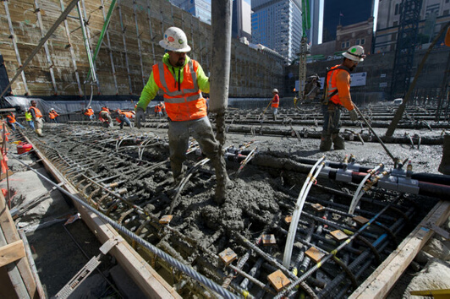 A record breaking 21,200 cubic-yard mat pour utilizing 227 ready mixed trucks and pouring 82 million pounds of concrete during an 18-and-a-half hour period was successfully placed on the 73-story Wilshire Grand project, the tallest structure west of the Mississippi. But this incredible feat wasn’t just happenstance; it required careful, deliberate and expert planning and coordination from the entire placement team. Ready mixed providers, concrete contractors and concrete pumpers must work cooperatively to achieve a more productive, safer and profitable pour.
A record breaking 21,200 cubic-yard mat pour utilizing 227 ready mixed trucks and pouring 82 million pounds of concrete during an 18-and-a-half hour period was successfully placed on the 73-story Wilshire Grand project, the tallest structure west of the Mississippi. But this incredible feat wasn’t just happenstance; it required careful, deliberate and expert planning and coordination from the entire placement team. Ready mixed providers, concrete contractors and concrete pumpers must work cooperatively to achieve a more productive, safer and profitable pour.
Pouring concrete is a lot more complex than filling a backyard pool. Contractors have to ensure that they have enough equipment to keep the flow going, that concrete gets poured before it hardens, that the right mix is being used, and more. On large projects, a successful pour requires a lot of planning.
“You have to plan your work and work your plan,” says Joe Sostaric, Vice President, The Conco Companies (Conco). The company completed the concrete work on the Wilshire Grand Project in downtown Los Angeles, which required placing 21,000 cubic yards of concrete in just 18 hours (a Guinness World Record). “The extensive amount of planning with the general contractor, ready mix supplier and other team members was the biggest factor in making this pour a success,” Sostaric continues. He reports Conco had more than 40 meetings with the general contractor in just six months in order to plan that job.
Besides, working your plan, Sostaric outlines five other ways to make your pours more profitable:
- Be conservative in your plan
- Have back up plans
- Review the mix design
- Hire the best
- Plan how it will end
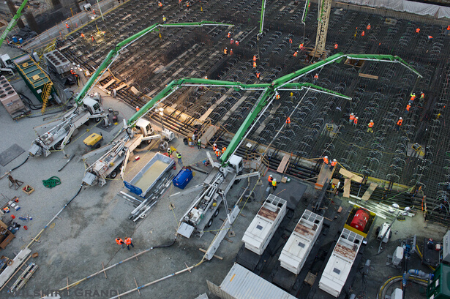 Be Conservative In Your Plan
Be Conservative In Your Plan
When you are detailing the scope of a plan, find out from each team if they can provide you with more than what you need to meet your desired pour rate. For example, if you need 1,000 cubic yards of concrete per hour and the ready-mix supplier can produce a maximum of 1,000 cubic yards, then you might be tempted to think that you have enough supply. But, what if something goes wrong at the plant, and they need to cut production for a couple of hours. Now, they’re not meeting the desired production rate, which means you can’t meet your desired pour rate. It would be better to find a ready-mix supplier (or multiple suppliers) that can produce 1,300 – 1,500 cubic yards per hour. By having ready-mix suppliers with excess capacity, that excess can serve as a buffer in case there is a decrease in the supply of ready-mix.
Take a similar approach to the equipment needed for the job. What machines do you need? What are their capacities? How many machines do you need? If using five machines running the entire duration of the project at maximum capacity will get the work done on time, get two more machines and don’t run the machines so hard. Again, if you need to run machines full throttle in order to achieve your desired pour rate, you risk not completing work on time if a machine breaks down.
On the Wilshire Grand Project, Conco placed enough equipment for a maximum pour rate of 2,500 cubic yards per hour. They determined 1,800 cubic yards per hour is a reasonable rate, and they averaged about 1,200 cubic yards per hour with peak hours exceeding 1,600 cubic yards per hour.
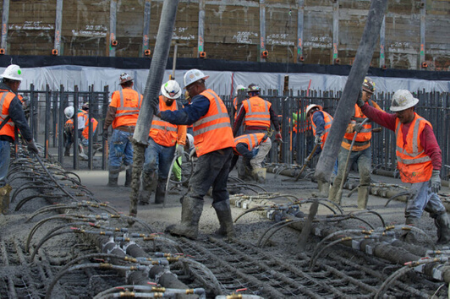 Have Back Up Plans
Have Back Up Plans
Don’t assume that everything is going to go smoothly throughout the entire pour. As mentioned above, there could be a problem with one of the ready-mix plants or with one piece of equipment. An accident on the freeway could delay concrete deliveries; a big event could occur on the same day as the pour, causing congestion that interfere with the smooth and timely flow of concrete. People might not show up for their shift. “You have to plan for the unexpected,” says Sostaric. “You have to plan for the worst-case scenario. Think about what has happened on past projects, and plan properly for it.”
The Wilshire Grand Project included 15 boom pumps, of which three were set aside as backup; those pumps weren’t deployed on that project, but they were available, in case one of the other boom pumps broke down.
“Once the pour begins, monitor progress to make sure it is going to plan, and if need be, make adjustments,” says Sostaric. “Let’s say you have a plan to pour 1,000 yards an hour. What happens if, during the course of the pour, you discover you can only place 800 yards an hour? You now have to regroup. Does it do any good to keep the flow of concrete exactly the same? Absolutely not. The concrete is going to stack up. Instead of having 20 trucks on site, you are going to have 50 trucks on site. And, instead of the concrete being one hour old at the point of placement, it’s two-and-a-half hours old and beginning to hydrate.”
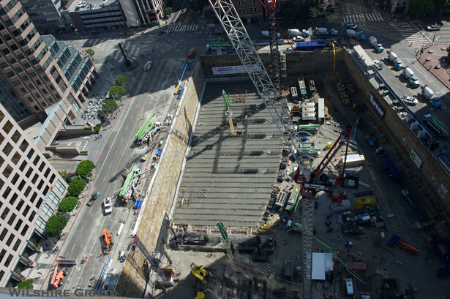 Review the Mix Design
Review the Mix Design
Concrete is composed primarily of five ingredients: cement, water, coarse aggregates, sand and admixtures. Different mix designs will affect the placeability, strength, long-term durability and appearance of the concrete. The right concrete mix can solve problems and the wrong mix can create them.
“We had to review the mix design for place and finish needs. The thermal properties of the concrete were studied. New mixes were designed and tested for lower ‘heat of hydration’. When you’re pouring concrete 20 feet thick, a lot of heat gets built up inside. We worked with CalPortland to modify the mix to make it work for us. We asked for a higher percentage of fly ash, because that reduces heat and delays the initial set of the concrete.”
Hire the Best
“What we look for is people who have a history of performing this type of work,” says Sostaric. “There are a lot of people who will overpromise what they can do. Even before you put out bids, you have to have an understanding of who is capable of performing the work. Have they completed something of the same magnitude that you are asking them to do? Do they have the necessary people? What is their safety record? Every contractor should have a short list of potential suppliers beforehand to make sure they have candidates with the capabilities needed to complete the work.”
The company also pays for all of their concrete pump operators to be trained through the American Concrete Pumping Association. “They have to take a test every few years to prove they are qualified to operate the equipment we put them on,” says Sostaric. “We want to make sure that they can do their job safely.”
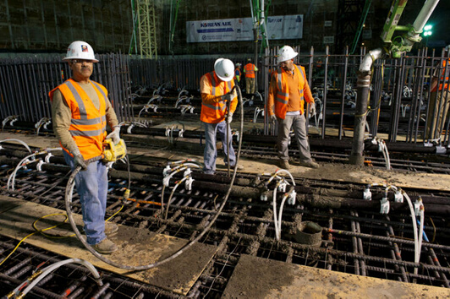 Plan How It Will End
Plan How It Will End
Ending a project can be tricky. If your concrete flow exceeds the placement rate, then you end up wasting concrete. If your concrete flow is less than the placement rate, then you end up wasting time.
“You have to have a plan for when the concrete tops off and the pumps shut down,” says Sostaric. “On the Wilshire Grand Project, we eventually reached a point where not all pumps could reach the slab. When we anticipated a pump was ready to shut down, we cut down the yards per hour coming from the plant. We didn’t want a big line of trucks at the end because we didn’t adjust the production rate.”
On the Wilshire Grand Project, of the 2,140 truckloads of concrete ordered, only two were returned.
“Large concrete pours have multiple concrete suppliers, so it can be challenging to know exactly where you’re at—how many trucks are on the road. Cut down the number of ready-mix suppliers as pumps come offline and that will make it easier for you to know how many trucks you have,” says Sostaric.
Conco Cement uses one point of contact between them and the ready-mix suppliers. “Communication is key,” says Sostaric. “You can’t have one person giving one answer and then another person giving another answer."
Want More Information?
This article was based on a presentation by Joe Sostaric, corporate vice president, The Conco Companies at CONEXPO-CON/AGG 2017.
CONEXPO-CON/AGG’s comprehensive Education Program is the leading source for contractors, business owners, construction material producers and end users to obtain cutting-edge information for today’s challenging economy and business model.
For those unable to attend the education sessions or who would like a copy of what was presented, recordings are available for purchase on a USB drive. There are over 130+ unique sessions from all ten education tracks: Aggregates, Asphalt, Concrete, Earthmoving & Site Development, Cranes, Rigging & Aerial Lift, Safety & Regulation, Technology, Equipment Management & Maintenance, Management: Business Best Practices and Management: Workforce Development.
For more information and to purchase education program recordings, visit education.












